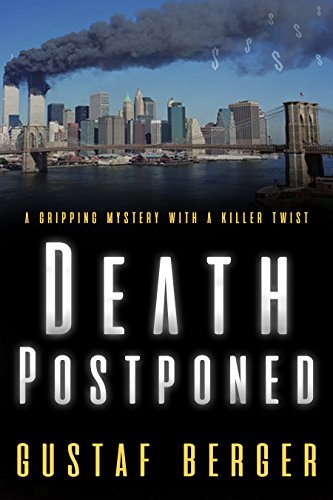 Happy to have ITW Debut Author Gustaf Berger as my guest blogger this week. Gustaf was born during WWII on the day the Japanese launched the first of their Kamikaze attacks on American warships.
Happy to have ITW Debut Author Gustaf Berger as my guest blogger this week. Gustaf was born during WWII on the day the Japanese launched the first of their Kamikaze attacks on American warships.By the time he was 44, he’d had two failed marriages, two distressed children, numerous affairs, and virtually no friends. He’d been kicked out of graduate school, fired from nine jobs, had gone through an addictive gambling phase, smoked marijuana all day, paid off buyers, policemen and insurance companies, never declared cash income on his taxes, and was heading toward his first bankruptcy – it got worse!
 While he eventually grew beyond those youthful peccadillos, Berger continues to live life on his own terms. He ran a mail order business and moved from New York City to Boston 20 years ago, where he met the love of his life, his sweetheart and muse – as well as his first reader – Amika. Both retired, they read, write, and travel the world extensively.
While he eventually grew beyond those youthful peccadillos, Berger continues to live life on his own terms. He ran a mail order business and moved from New York City to Boston 20 years ago, where he met the love of his life, his sweetheart and muse – as well as his first reader – Amika. Both retired, they read, write, and travel the world extensively. He began writing eight years ago after his business went south during the recession. He’s never been happier. Six of his short stories have been published by literary journals. Death Postponed, which he worked on for five years (taking breaks to write three other books) is his first published novel. He looks forward to writing until he becomes physically unable to tap those keys.
As a Reader, I love Bookstores. As an Author…
I love bookstores. Couldn’t leave one without buying. That is, until my first novel was accepted for publication.
From the day I signed the contract, I studied book marketing, set up a website, began a newsletter, contacted local bookstores, ran Facebook promotions, and even paid for a Kirkus review – I wasted my time and money.
The day my masterpiece was released, over 3000 other titles came to market in the US. Same every day. Each year, more than one million new books join the existing 14 million available for sale.
As an author with no fame, no platform, and few contacts – how could I compete? I asked my publisher what I should do – I assumed we had the same interest. Their advice: post on Facebook.
I scaled back my expectations. At least I could sell locally. Thirty thousand artsy and erudite folks live in our city neighborhood, most within walking distance of a recently opened bookstore where I shopped, valuing the owner’s suggestions. That’s what’s special about local bookstores: knowledgeable advice, cozy surroundings, the thrill of discovery.
There was no bookstore in the small town where I grew up. We used the town library, a treasure with helpful and patient librarians.
Over the years since then, I’ve used libraries for research and bought most of my books from local stores and second-hand sellers, who were plentiful in NYC. I shopped at the original Barnes & Noble in downtown Manhattan (before they went national) and at the beautiful, landmark Scribner’s (1913-1989) in midtown. One can still spend hours perusing the 2.5 million new and used books at Strand Bookstore (1927) – the lone survivor from the 48 other bookstores that once surrounded it. Rising rents and competition did most of them in.
The book business tumbled forward. Barnes & Noble, Borders, and other chains pushed many small independents out of business. Book buying became more impersonal. Then Amazon, the monster we resent but can’t live without, exploded onto the web, crushing most competition. Now I download most books into my Kindle and shop at local bookstores for the occasional print version. As a consumer, I feel I get the best of both.
As an author, however, I feel betrayed. Four months before release date, I dropped by that local bookstore to announce my accomplishment. The owner, Pat (not actual name,) was sitting hunched over a computer screen behind a small table. A carefully curated collection of books fill the cozy space. Without looking up from her computer, she said, “Have your publisher send a review copy.” No warmth. No congratulations. Didn’t ask anything about the book. When I reminded her that I live in the neighborhood and I’m a customer, she said, “There are plenty of authors around here.”
Phew. I stepped outside to thaw out. It didn’t end there.
After I received review copies, I again approached Pat. I was proud of the layout as well as the evocative cover of my 9/11-based twisty mystery. She said, “Leave me a copy. We’ll look at it.” I still haven’t gotten their review.
Pat told me they’d only order the book if one of their wholesalers listed it. There are three major book wholesalers: Ingram Content Group, Independent Publishers Group, and Baker & Taylor, who does carry it. But after she checked, she refused to stock the book even though all unsold copies are refundable.
The reason was strictly business. My book was print-on-demand and the resulting 25% discount – way below the typical 40 to 50% — is too small for a bookstore to survive on. I understood that, so I gave her another option: I’d supply them with all the books needed and, after many months of selling, they just make one order from my publisher (at 46% discount) and pay me back with books. No risk. Pure profit. Pat said, “Too much trouble.”
In spite of the resistance, I asked if they would host a book release party. I assured them a healthy turnout; we’ve lived here for years and know a lot of people.
“Nope. Booked up all spring.”
Pat did agree to special order books if people asked for them, but she didn’t even put the review copy on display.
I also e-mailed the book buyer of a large independent bookstore five miles away, enclosing a press release and reviews, letting her know I was a customer too. I sent the first e-mail a month before the release, another upon release, and a third a month later. No response. I called the store manager and she took seven copies on consignment, meaning they’d pay me for whatever books they sold, returning the rest.
For my release party I chose a local restaurant that has a tiny music and book store in the rear. They were easy to deal with, and it was a great success. Sixty people came, thirty-three books sold, and the store kept copies for future sales. They had no problem ordering from my publisher.
To date, Pat has sold 16 copies to people I’d sent to her store. She did nothing to earn it. Not only was she rude to me personally, she made a terrible business decision. If she had worked with me, her total sales to date (6 months) would be over 50 copies at a gross profit of $350. (50x$7.00) With no money invested. If she sold every book they carry that well, her profits would be well over one million dollars. (est. 3000 books x 50 x $7.00.) In her wildest fantasies!
I stopped shopping at her store.
The Bad News for Writers
It’s unrealistic to expect bookstores to carry yours, except on consignment. Depending on the category, a bookstore stocks one in a hundred to one in a thousand of available titles.
2007 was the peak selling year for books. Demand has declined significantly since then, but twice as many books are being published. The average sale for a book in its first year is under 200 copies. And that includes every bestseller. The median sale is closer to 100 copies.
Keep your hopes high, your expectations low, and good luck.
Gustaf Berger, author of Death Postponed


